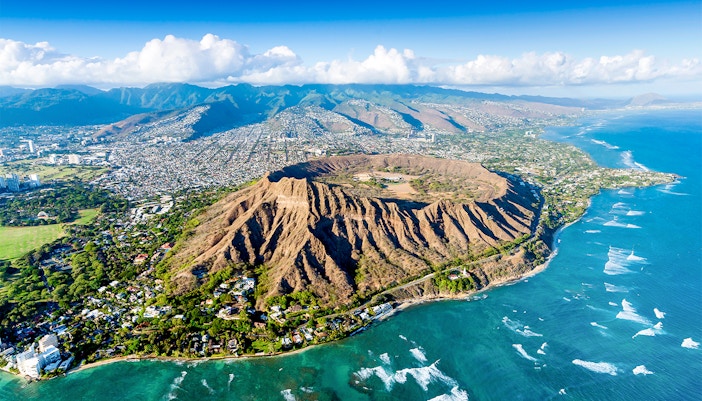From the moment you step onto the platform, you’re surrounded by one of the most dramatic views in Hawaii. Look out across the emerald valleys of Kailua and Kaneohe, the turquoise ocean, and the steep Koolau cliffs. It’s a sight that captures Oahu’s wild beauty perfectly.
Nuʻuanu Pali lookout: Where Oahu’s past and beauty collide
Nuʻuanu Pali lookout in a nutshell

- Must-see highlights: Expansive views of Oahu’s lush windward valleys, the towns of Kailua and Kaneohe, and the Koolau cliffs.
- Unique fact: The lookout’s powerful winds are so strong that they can lift lightweight objects. Locals joke you’ll get a free “Hawaiian-style blow-dry” when you visit.
- Current use: A popular scenic overlook and historic site offering incredible photo ops, powerful winds, and panoramic island views.
What to do at Nuʻuanu Pali lookout
Soak in the unforgettable view
The dramatic geology of the Koolau cliffs

Volcanic origins
The cliffs you see from the lookout are remnants of the ancient Koolau Volcano, which formed nearly 2.5 million years ago. The volcano’s windward side eventually eroded, creating the towering cliffs and lush valleys seen today.

Carved by nature
Over time, wind, rain, and vegetation sculpted the Koolau range into steep, green ridges that seem to drop straight into the ocean. The Nuʻuanu Valley formed as erosion cut through the volcanic rock, creating the natural pass that the highway follows today.

A geological showcase
Standing at the lookout gives visitors a rare perspective on how Oahu’s mountains were shaped by both volcanic power and millions of years of weathering, a dramatic reminder of the island’s dynamic origins.
Know before you go

Timings
- Open: Daily from 6pm to 6pm
Location
- Address: Nuuanu Pali Dr, Kaneohe, HI 96744, United States | Find on Maps
Accessibility
- The lookout is accessible via a short paved path from the parking area.
- It’s suitable for most visitors, though winds can be strong.
Facilities
- Restrooms are available near the parking area.
- Limited parking is available with a fee.

- Bring a light jacket or windbreaker. The lookout sits over 1,000 feet above sea level, and the winds funneling through the mountain pass can be surprisingly strong and chilly, even on sunny days.
- Visit in the morning for the best experience. Early hours often bring clearer skies, softer light for photography, and far fewer crowds than midday, giving you more space to fully take in the sweeping views.
- Hold onto your belongings carefully. The powerful gusts here are part of the lookout’s charm, but they can easily blow away hats, scarves, or lightweight items.
- Keep cameras, phones, and personal items secure to prevent them from being blown away by the wind.
- Combine your visit with nearby attractions to make a full day of exploring. You can include stops like Lulumahu Falls, the historic Old Pali Road, or a scenic drive along Pali Highway.
- Take time to read the interpretive signs. The lookout is not just about the views; it’s also a historic site. The signs share fascinating stories about the battle fought here, the cliffs, and the local culture, adding depth and context to the dramatic scenery.
Frequently asked questions about Nuʻuanu Pali lookout in Oahu
Yes, many full-day Oahu sightseeing tours, including the Pearl Harbor & Grand Circle Island Oahu Full-Day Tour, include a stop or pass-by at the lookout. Guided tours provide historical context and highlight the best viewpoints.
Entry to the lookout is free, though a small parking fee applies. Payment is usually by card at the kiosk.
The lookout sits in a natural mountain pass where trade winds funnel through the Koolau Range, creating incredibly strong gusts that can feel like nature’s own wind tunnel! It’s one of the most famously windy spots in all of Hawaii.
Yes, basic facilities, such as restrooms and a small parking area, are available near the lookout. Keep in mind that parking can fill up quickly during peak hours, so arriving early is recommended.
No hike is required. The main lookout is just a short walk from the parking area, making it accessible to almost all visitors. However, if you want a more active experience, nearby trails like sections of the Old Pali Road offer longer walks and closer encounters with the cliffs and surrounding forest.
Yes! Sections of the historic Old Pali Road are still accessible and can be explored on foot. This trail winds through lush forested areas beneath the cliffs and offers a quieter, more immersive way to experience the same dramatic landscape that travelers and warriors once navigated centuries ago.
Early mornings, between 6am and 8am, are ideal for clear skies, cooler temperatures, and fewer crowds. Late afternoons, roughly 4pm to 6pm, offer softer light that’s perfect for photography and a chance to enjoy the dramatic sunset over the cliffs and ocean. Midday tends to be warmer and busier, so visiting during these windows gives the best overall experience.
No, drones are not permitted at the lookout due to safety regulations and preservation rules. Handheld cameras and smartphones work perfectly for capturing the views.









